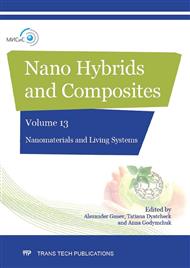p.176
p.183
p.190
p.199
p.206
p.211
p.219
p.225
p.232
Determination of Silver Nanoparticle Concentration Ratio in the Blood and Brain of Rats for Different Administration Routes
Abstract:
A study to assess the concentrations ratio of silver nanoparticles (Ag-NPs) in the blood and brain of the male Wistar rats using nuclear physical methods has been carried out. The Ag-NPs suspension including quasi-spherical Ag-NPs was administrated intravenously (in the tail vein for Ag-NPs of 9+2 nm and 94+10 nm), and for Ag-NPs of 94 nm diameter it was also administrated orally and intratracheally. The organ recovery was made in 24 h following the administration (for three types of administration) and one more time in 120 h in case of intravenous administration. Radioactive label in the nuclei of silver was created by irradiation of Ag-NPs suspensions in a flow of reactor thermal neutrons, and its share was 5.6 ∙ 10-7 of the total number of silver atoms. This fact could not affect the overall physical and chemical properties of radiolabeled Ag-NPs. We measured the activity of the 110mAg isotope-label in samples of blood and brain of rats, while the activity of 59Fe isotope was measured after the exposure to samples of these organs.Given the fact that iron is contained mainly in the hemoglobin of blood, on the basis of the measurement of 59Fe activity being the induced by neutron flux, we derived an evaluation of the residual mass of blood in brain capillaries using a standard procedure to prepare the samples. This determination is 0.058±0.010 g, and on average this is about 0 37±0.09% of the total mass of blood in rats. The estimated ratio of the Ag-NPs concentration in brain samples of rats (minus the Ag-NPs number in residual blood capillaries) to their peripheral blood concentration for 9 nm Ag-NPs is 0.16±0.04 and 0.31±0.07, and for 94 nm Ag-NPs - 0.20±0.05 and 0.29±0.07 for times in 24 and 120 hours after intravenous administration, respectively. For Ag-NPs of 9 nm and 94 nm diameter we revealed no significant effect of the Ag-NPs size on the value of this ratio. The same ratio for Ag-NPs of 94 nm diameter in 24 h after the oral and intratracheal administration is 0.29+0.09 and 0.41+0.12, respectively.
Info:
Periodical:
Pages:
206-210
Citation:
Online since:
January 2017
Price:
Сopyright:
© 2017 Trans Tech Publications Ltd. All Rights Reserved
Share:
Citation:


